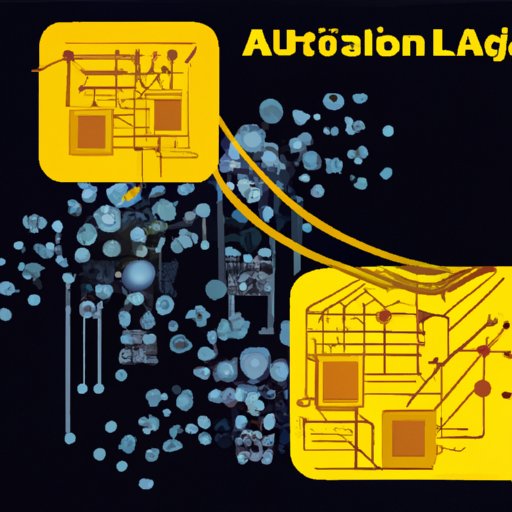Introduction
Artificial Intelligence (AI) has revolutionized the way we live and interact with the world around us. From automated checkouts to self-driving cars, AI algorithms are now being used in a wide range of applications. But what exactly is an AI algorithm? How does it work? And why is it so important? This article will answer these questions and provide a comprehensive guide to understanding what an AI algorithm looks like and how it works.
A Comprehensive Guide to Understanding the AI Algorithm
An AI algorithm is a set of instructions or rules that enable computers to solve problems and make decisions. AI algorithms are used to analyze data, recognize patterns, and learn from past experiences. In order to understand what an AI algorithm looks like, it’s important to understand the following three components: data structures, machine learning, and neural networks.

Exploring the Building Blocks of an AI Algorithm
Data structures are the foundation of any AI algorithm. They are used to store and organize large amounts of data in a way that makes it easy for computers to access and manipulate. Data structures can be as simple as a linked list or as complex as a graph. By understanding how data structures work, developers can create more efficient AI algorithms.
Machine learning is the process of teaching computers to recognize patterns and make predictions based on past data. It is the most common type of AI algorithm and is used in a variety of applications such as facial recognition, object detection, and natural language processing. By using machine learning, developers can create AI algorithms that can learn, adapt, and improve over time.
Neural networks are a type of AI algorithm that mimics the human brain. They are made up of interconnected layers of “neurons” which process data and make decisions. Neural networks can be used for a variety of tasks including image recognition, speech recognition, and autonomous driving.
The Benefits and Challenges of Implementing an AI Algorithm
There are many advantages to implementing an AI algorithm. For example, they can automate tedious and repetitive tasks, personalize experiences for users, and make better and faster decisions. AI algorithms can also help save time and money by reducing the need for manual labor and increasing efficiency.
However, there are also some potential drawbacks to implementing an AI algorithm. Because they rely on large amounts of data, they can be difficult and expensive to develop and maintain. Additionally, AI algorithms can be prone to bias and errors if not properly tested and monitored.

How AI Algorithms are Revolutionizing Our Lives
AI algorithms are revolutionizing our lives in a variety of ways. Automation is one of the most prominent uses of AI algorithms. Automated systems can be used to perform mundane tasks such as sorting data, responding to customer inquiries, and managing inventory. AI algorithms can also be used to personalize experiences for users by providing tailored recommendations and content.
AI algorithms are also being used to make decisions. For example, AI algorithms can be used to determine whether a loan application should be approved or denied, or to detect fraud. By leveraging the power of AI algorithms, businesses can make better decisions faster and with greater accuracy.
Demystifying the Complexities of AI Algorithms
Despite their complexity, AI algorithms can be implemented successfully with the right planning and resources. It’s important to understand the different types of AI algorithms and how they work in order to choose the best one for your needs. Additionally, it’s important to test and monitor AI algorithms to ensure they are performing as expected.
It’s also important to be aware of common misconceptions about AI algorithms. For example, AI algorithms can’t think for themselves – they require humans to provide them with data and instructions. Additionally, AI algorithms are not infallible – they can make mistakes and can be prone to bias if not properly tested and monitored.
Real-World Examples of AI Algorithms in Action
AI algorithms are being used in a variety of applications today. Automated checkouts, self-driving cars, and smart home devices are all powered by AI algorithms. Automated checkouts use AI algorithms to scan items and calculate prices. Self-driving cars use AI algorithms to detect obstacles and navigate roads. Smart home devices use AI algorithms to automate tasks such as turning off lights and adjusting thermostats.

An Overview of Popular AI Algorithms Used Today
Linear regression is one of the most popular AI algorithms used today. This algorithm is used to predict values based on input data. Naive Bayes is another popular AI algorithm and is used for classification tasks such as spam filtering. Support vector machines are used for classification and regression tasks and are often used for image recognition and text classification.
Conclusion
In conclusion, AI algorithms are powerful tools that can be used to automate tedious tasks, personalize experiences, and make better decisions. They are made up of data structures, machine learning, and neural networks. While there are many advantages to implementing an AI algorithm, there are also potential drawbacks. It’s important to understand the complexities of AI algorithms in order to successfully implement them. Finally, AI algorithms are being used in a variety of real-world applications today, from automated checkouts to self-driving cars.
By understanding what an AI algorithm looks like and how it works, developers can create more efficient and effective algorithms. With the right planning and resources, AI algorithms can be used to revolutionize the way we live and work.
(Note: Is this article not meeting your expectations? Do you have knowledge or insights to share? Unlock new opportunities and expand your reach by joining our authors team. Click Registration to join us and share your expertise with our readers.)
